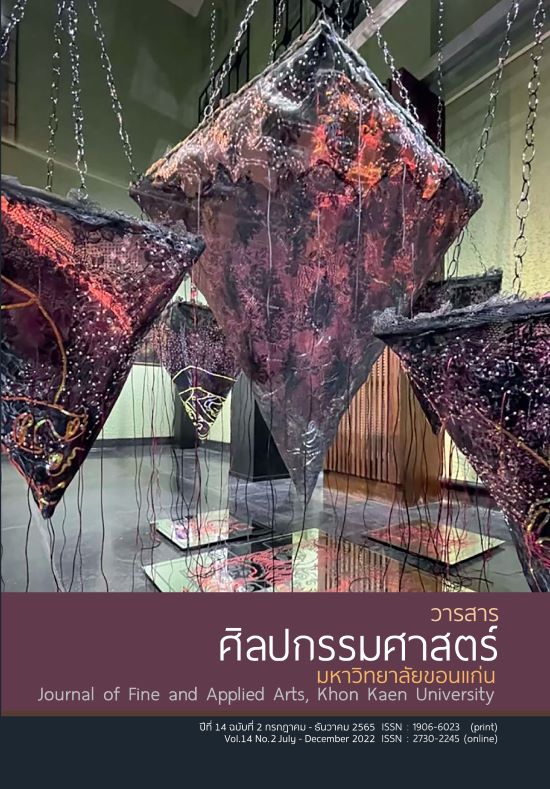Application of Thai Dance Posture in Muscle Exercises to Increase Muscle Strength and Weakness among Office Workers
Main Article Content
Abstract
The purpose of this research was to create a muscular dance movement for office workers. And to study the effect of creating a dance posture for muscle management for office workers. The sample group in this research Is an office worker of the Department of Disease Control Passed the morning-elimination criteria, 30 people participated in a dance program for muscle management for office workers for 8 weeks, 3 times a week (Monday, Wednesday, Friday) 60 minutes each time. Divided into 3 periods: warm-up period Stretching training sessions and muscle relaxation period. Data were collected using the physical fitness test of the Department of Physical Education. Muscle strength and Flexibility before and after the experiment. The statistics used to analyze the data were mean standard deviation, and One-way repeated measure ANOVA. The results showed that 1) the strength of the muscles of both arms. More than before participating in activities statistically significant at a level of 0.05 2) the strength of the muscles of the legs More than before participating in activities statistically significant at a level of 0.05 3) softness More than before participating in activities statistically significant at a level of 0.05
Article Details

This work is licensed under a Creative Commons Attribution-NonCommercial-NoDerivatives 4.0 International License.
Content and information in articles published in the Journal of Fine and Applied Arts of Khon Kaen University is regarded as the opinion and sole responsibility of the author(s) directly; therefore, editors are not obliged to agree to or share any responsibility with regard to the content and information that appears within these articles.
All articles, information, content, image, etc. that have been published in the Journal of Fine and Applied Arts of Khon Kaen University is the copyright of the Journal of Fine and Appllied Arts of Khon Kaen University. Any person or organization who wishes to distribute all or parts of the articles for further dissemination or other usage must first receive permission from the Journal of Fine and Applied Arts of Khon Kaen University before proceeding to do so.
References
กองกิจกรรมทางกายเพื่อสุขภาพ กรมอนามัย. (2562). รอบรู้สุขภาพวัยทำงาน. กรุงเทพฯ : คิวคัมเบอร์ (ประเทศไทย).
กัญญาวีร์ เปี้ยนสีทอง. (2560). การบริหารกล้ามเนื้อในผู้สูงอายุ โดยใช้กิจกรรมนาฏศิลป์บำบัด สำหรับชุมชนไทยพวน จังหวัดนครนายก. ปริญญานิพนธ์ปริญญาการศึกษามหาบัณฑิต สาขาศิลปศึกษา บัณฑิตวิทยาลัย มหาวิทยาลัยศรีนครินทรวิโรฒ.
ณัฐธร ขุนทอง. (2554). ผลการฝึกรำมโนราห์ที่มีต่อความแข็งแรงและการทรงตัวของผู้สูงอายุ. ปริญญานิพนธ์ปริญญาการศึกษามหาบัณฑิต สาขาพลศึกษา บัณฑิตวิทยาลัย มหาวิทยาลัยศรีนครินทรวิโรฒ.
นภษร ศรีวิลาศ. (2560). อ่อนช้อยนางรำคาร์ดิโอ้แบบไทยๆ ที่อ่อนช้อยและแข็งแกร่งไปพร้อมกัน. ค้นเมื่อ 25 กุมภาพันธ์ 2562, จาก https://readthecloud.co/entrepreneur-12/
นิภาพร เหล่าชา. (2553). ผลของการออกกำลังกายท่าฤาษีดัดตนที่มีต่อความแข็งแรงของกล้ามเนื้อและความอ่อนตัวในผู้หญิงวัยทำงาน. วิทยานิพนธ์ปริญญาวิทยาศาสตรมหาบัณฑิต สาขาวิทยาศาสตร์การกีฬา บัณฑิตวิทยาลัย จุฬาลงกรณ์มหาวิทยาลัย.
นิวัฒน์ บุญสม. (2560). การพัฒนาความอ่อนตัวด้วยการยืดเหยียดกล้ามเนื้อ. วารสารอิเล็กทรอนิกส์ Veridian มหาวิทยาลัยศิลปากร (มนุษยศาสตร์สังคมศาสตร์และศิลปะ), 10(2), 2173-2184.
พจนานุกรมฉบับราชบัณฑิตยสถาน. (2546). ดนตรี. กรุงเทพฯ : นานมีบุ๊คส์พับลิเคชั่นส์.
ไพศาล จันทรพิทักษ์. (2557). การสร้างความแข็งแรงให้กล้ามเนื้อ. ค้นเมื่อ 20 มิถุนายน 2562, จาก http://www.bangkokhealth.com/health/article
โรงพยาบาลกรุงสยามเซนต์คาร์ลอส. (2562). ออฟฟิศซินโดรม. ค้นเมื่อ 3 มิถุนายน 2562, จาก http://www.stcarlos.com
วิศาล คันธารัตนกุล. (ม.ป.ป.). การออกกำลังกายในวัยทำงาน. กรุงเทพฯ : กองออกกำลังกายเพื่อสุขภาพ กรมอนามัย.
สถาบันบัณฑิตพัฒนศิลป์. (2558). นาฏศิลป์ไทย รำ ระบำ ละคร โขน. กรุงเทพฯ : สถาบันบัณฑิตพัฒนศิลป์ กระทรวงวัฒนธรรม.
สำนักการแพทย์ กรุงเทพมหานคร. (ม.ป.ป.). โรคออฟฟิศซินโดรม. ค้นเมื่อ 25 สิงหาคม 2562, จาก http://www.msdbangkok.go.th/healthconner_Office%20syndrome.htm
สำนักงานกองทุนสนับสนุนการสร้างเสริมสุขภาพ. (2558). สัญญาณเสี่ยงโรคออฟฟิศซินโดรม. ค้นเมื่อ 29 สิงหาคม 2562, จาก https://www.thaihealth.or.th
สำนักงานสถิติแห่งชาติ. (2561). การสำรวจการมีการใช้เทคโนโลยีสารสนเทศและการสื่อสารในครัวเรือน พ.ศ. 2561 (ไตรมาส 1). กรุงเทพฯ : สำนักงานสถิติแห่งชาติ.
สำนักวิทยาศาสตร์การกีฬา กรมพลศึกษา. (2556). การยืดเหยียดกล้ามเนื้อด้วยหลักวิทยาศาสตร์การกีฬาในนักกีฬา. ค้นเมื่อ 3 กรกฎาคม 2562, จาก. https://www.dpe.go.th/ dwl-preview-401891791937
สำนักวิทยาศาสตร์การกีฬา กรมพลศึกษา. (2558). แบบทดสอบและเกณฑ์มาตรฐานสมรรถภาพทางกายของประชาชน อายุ 19–59 ปี. กรุงเทพฯ : กรมพลศึกษา.
อัจจิมา สวัสดิชีวิน. (2548). นาฏยบำบัด. กรุงเทพฯ : มหาวิทยาลัยราชภัฏธนบุรี.


